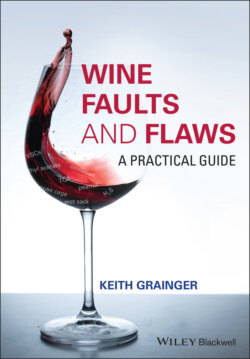Читать книгу Wine Faults and Flaws - Keith Grainger - Страница 46
2.3.2.1 Tasting Glasses
ОглавлениеIt is important to taste wines using appropriate glasses. Experts do not universally agree as to the detailed design of the ideal tasting glass, but certain criteria are essential. Two of the key characteristics are:
Fine rim: A fine rim glass will roll the wine over the tip of the tongue, whilst an inexpensive glass with a beaded rim will throw the wine more to the centre. The tip of the tongue is the part of the mouth where we most detect sweetness, with other parts of the tongue being less sensitive to this;
Cup tapering inwards: The cup of the glass must taper inwards towards the top. This will develop, concentrate, and retain the nose of the wine in the headspace above the liquid, and also facilitate tilting the glass and swirling the wine. Cut glass is not appropriate for wine tasting, as it is impossible to ascertain the true depth of colour and brightness.
Glasses manufactured to the ISO tasting glass specification ISO 3591:1977 [6] remain popular among many wine tasters, both professional and amateur. The ISO tasting glass is particularly good at revealing those faults perceptible on the nose. The International Organisation of Vine and Wine (OIV) recommends the use of tasting glasses that comply with the requirements of ISO 3591, and that glasses are rinsed in ultra‐filtered and deionised water [7]. Whether ISO glasses are the best glass for tasting particular wine types is subject to much dispute. The nose of full‐bodied and complex red wines certainly develops more in a larger glass. Wine glass manufacturers, particularly Riedel and Zwiesel, have designs to bring out the best of individual wine types, so perhaps the only real advantage of the ISO glass is that it is a standard reference.
An appropriate tasting sample is 3–4 cl, which will be sufficient for two or three tastes. Pouring 5 cl into the glasses allows tasters to return for further assessment should this be required. If glasses of a larger size than the standard ISO tasting glass are used, it is appropriate to pour correspondingly more wine.
